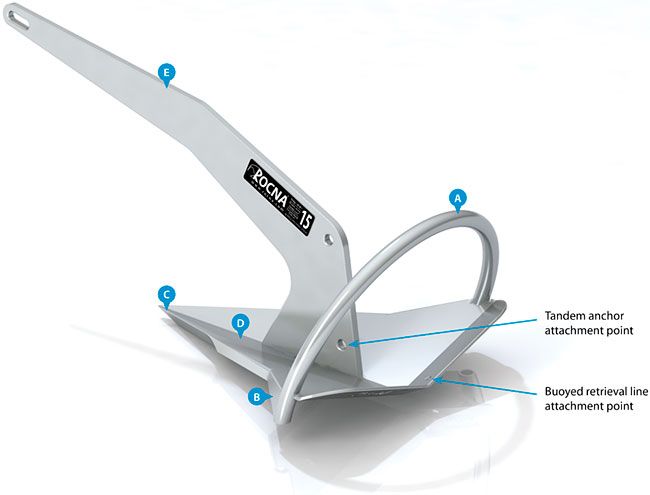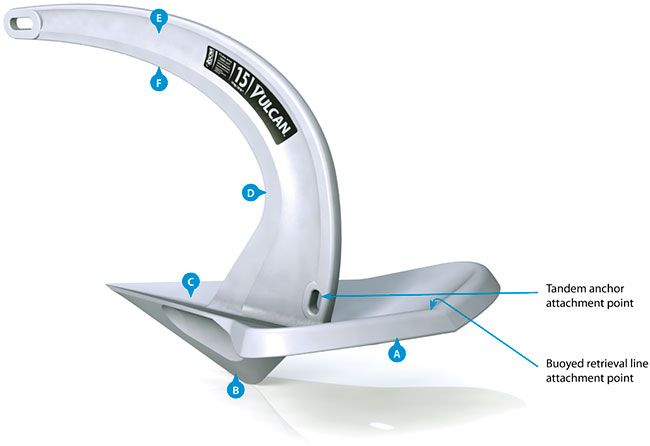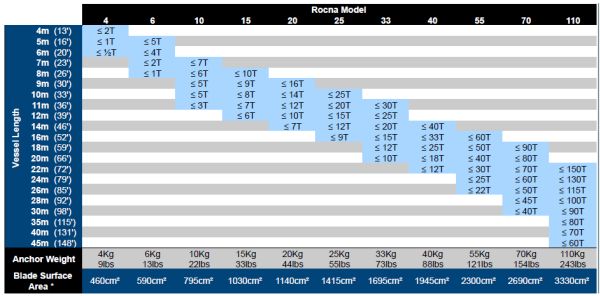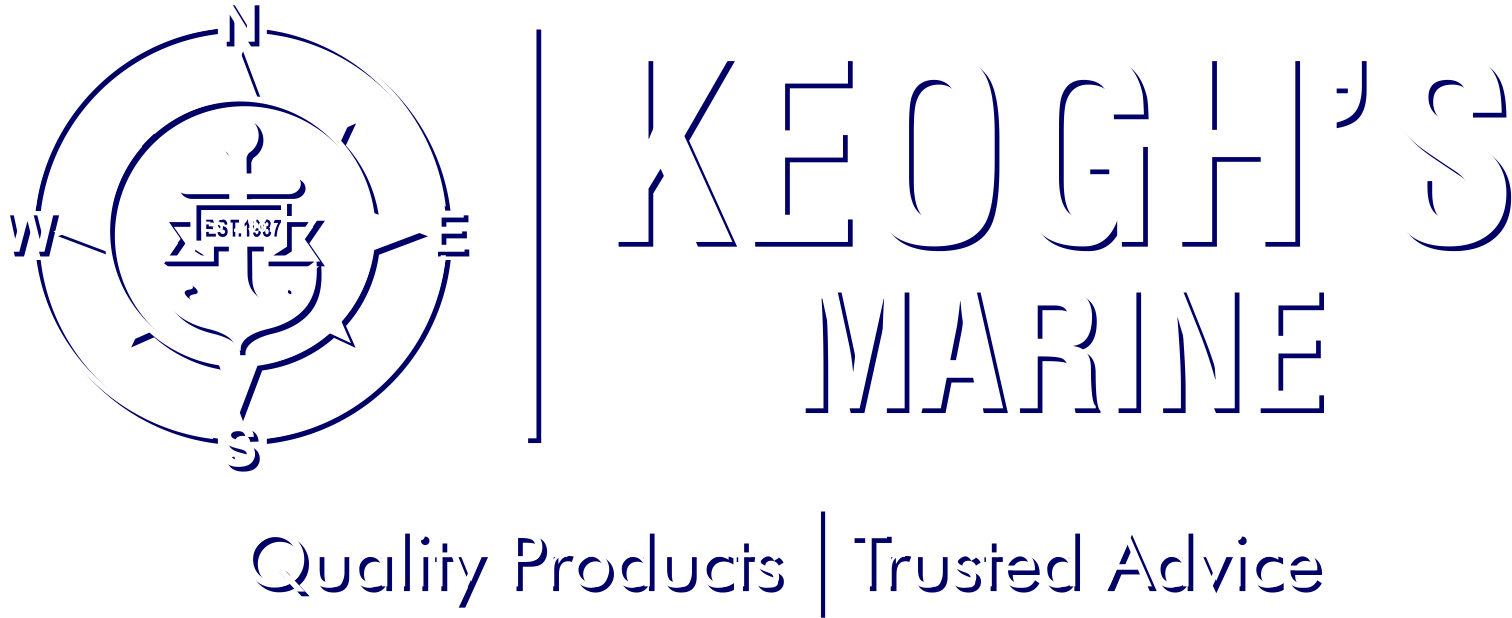Rocna and Vulcan Anchors
Peter Smith, designer of the Rocna, has been building, racing, and cruising sailing yachts since the early 1960's. In 1978, Pete walked away from his successful yacht production company Cavalier Yachts to go cruising with his wife Josephine. Thirty-three years and well over 100,000 nautical miles later, he’s still cruising on his current yacht Kiwi Roa, the result of over a decade of planning and design work.
A boat-builder by trade, Pete built Kiwi Roa over a five-year period to be his ultimate cruising yacht (her design philosophy matches that of the Rocna: bulletproof.)
15m (50') long, she is built from 10 mm aluminium alloy plate (up to 25 mm in some sections), displaces 27 tons, and is designed to withstand the worst conditions Mother Nature – or man – can throw at her.
Pete, together with Jo and their son Craig, sailed Kiwi Roa from England to New Zealand during the period 1994 – 1998. Although extremely well set-up, Kiwi Roa experienced frequent problems when anchoring. Soft mud areas such as the English East Coast, the Chesapeake, and the Delaware Bay presented particular problems.
Pete had used every type of anchor known to man. Kiwi Roa carried a 110 lb CQR, an 88 lb Delta, and a 110 lb Bruce, but there was always a feeling of insecurity. So, in the New Zealand tradition of do-it-yourself, he built the first Rocna prototype, a 50 kg concept model which was tested during a circumnavigation of New Zealand. It endured hundreds of uses in conditions that included 70 knots on-and-off for ten days in Stewart Island, and 50 knots for two days in Akaroa. While other boats were having anchor trouble, Kiwi Roa did not move.
As word of the Rocna’s formidable holding power spread among the cruising community, other sailors started to ask Pete for a Rocna of their own. Rocna anchors are now available in over 40 countries worldwide.
Peter’s recent sailing has been in the Atlantic, both south and north. After several years in Patagonia and Tierra del Fuego, and expeditions to Antarctica and the South Atlantic islands of the Falklands and South Georgia, Kiwi Roa has been in South Africa and the western African coast before making the big jump to Newfoundland and Greenland. To find out more about Peter's adventures, including comprehensive photo journals, visit his personal website at PeterSmith.net.nz.
Canada Metal (Pacific) Ltd brings a strong quality control background to the manufacturing of the Rocna anchor family. As the world’s largest manufacturer of marine anodes, and supplier to the major marine engine manufacturers, we are extremely familiar with producing metal products to exacting chemical and dimensional tolerances.
Since taking over Rocna anchor production, these quality control processes and procedures developed at our head office in Vancouver, BC, Canada have been incorporated into anchor manufacturing through our wholly owned subsidiary in China. Material traceability is one of the key elements of this program. Through tracking numbers embossed on every anchor, it is possible to trace the steel used in the anchor back to the original material certificates documenting its composition and mechanical properties.
There are multiple inspection points during the production of every anchor, both at the sub-assembly level and at final assembly. Our inspectors take quality very seriously, and maintain extensive documentation on each and every production run.
Canada Metal (Pacific) Ltd brings a strong quality control background to the manufacturing of the Rocna anchor family. As the world’s largest manufacturer of marine anodes, and supplier to the major marine engine manufacturers, we are extremely familiar with producing metal products to exacting chemical and dimensional tolerances.
Since taking over Rocna anchor production, these quality control processes and procedures developed at our head office in Vancouver, BC, Canada have been incorporated into anchor manufacturing through our wholly owned subsidiary in China. Material traceability is one of the key elements of this program. Through tracking numbers embossed on every anchor, it is possible to trace the steel used in the anchor back to the original material certificates documenting its composition and mechanical properties.
There are multiple inspection points during the production of every anchor, both at the sub-assembly level and at final assembly. Our inspectors take quality very seriously, and maintain extensive documentation on each and every production run.
Robotic welding is used in the production of the anchors, to ensure consistency from one unit to the next.
Hot dip galvanizing is used to ensure a durable finish, and is carefully monitored to ensure the composition and thickness of the galvanizing layer.
The Rocna is an SHHP (Super High Holding Power) type anchor. During seabed testing for classification, Rocna anchors exhibited the highest holding power of any anchor that classification society RINA had ever certified. And when tested to destruction, Rocna anchors exhibit strengths up to six times the SHHP proof load requirements.
Currently sizes 55 kg (121 lb) to 110kg (243 lb) (galvanized models only) are fully type approved and classified by RINA. We are currently in the process of updating the Rocna SHHP classification for the full Rocna Original galvanized product range.
Rocna - The Original
ROCNA: CHANGING THE STATUS QUO
The Rocna anchor was designed by New Zealand sailor Peter Smith, who has been designing, building, and sailing boats since the early 1960’s. Over 100,000 nautical miles of cruising, Peter experienced the same anchoring problems that are still prevalent today – needing to carry a variety of anchors to suit various seabeds, yet still the anchors dragged and boaters felt insecure.
"Your anchor should provide you and your crew with reliability, security, and confidence," says Peter. A lifetime of nautical experience worldwide was poured into an anchor – initially conceived for Peter’s own use – which became the Rocna.
AN INDEPENDENTLY TESTED NEW GENERATION DESIGN
Peter’s solution consistently returns top results in objective and independent testing. Since its launch in 2004, the Rocna has led worldwide anchor tests as published in the likes of SAIL, Yachting Monthly, Practical Boat Owner, Voile, and others. Because of the Rocna’s reliable and convincing performance against its competition, Rocna is trusted to be rock solid in the real world. You don’t need to take our word for it.
FOR ALL WHO NEED RELIABILITY FROM PERFORMANCE
Rocna anchors are performing in some of the world’s toughest locales, including Patagonia, Antarctica, Alaska, Greenland, Scotland – as well as enduring temperamental tropical weather. Rocna has "buy-in" from respected boaters whose opinions matter, from Steve Dashew to Jimmy Cornell. Southern lattitudes sailing pioneer Jérôme Poncet reports: "It took me years with many trials to achieve, in discovering the Rocna anchor, foolproof holding power…"
 PRECISION SETTING
PRECISION SETTING
The roll-bar (A) ensures that the anchor always arrives at the ideal angle for penetration, and the setting skids (B) guide the fluke tip (C) which acts as a sharp chisel cutting into the seabed. With a third of the anchor’s weight on its fluke tip, an instant reliable set is ensured with every use.
ROCK SOLID HOLDING POWER
Of all anchor types, a concave fluke (D) gives the greatest resistance, and through clever design Rocna provides the largest fluke area possible. In very soft seabeds, this provides the holding power to secure your boat. On hard or weedy sea floors, Rocna’s chisel tip (C) ensures that it cuts through and bites deep.
MAXIMUM VERSATILITY
The Rocna is a true multi-purpose anchor that sets and holds in most seabeds, from soft mud to hard sand, clay, grass, and kelp.
RESISTANT TO WIND AND TIDE SHIFTS
A Rocna remains stable and buried, and does not roll out on reversal or veering of load, or if dragged beyond yield, providing enhanced security.
HIGHEST QUALITY BUILD AND FINISH
Compare the welds and finish on a genuine Rocna anchor to alternatives. We believe a top performing product should be built like one, and we spend a lot of time and resources on production and quality control procedures to ensure that this is the case.
HIGH TENSILE STEEL SHANK (E)
Rocna anchors are designed – and built – for strength and durability.
SELF-DEPLOYING AND SELF-RECOVERING
The Rocna shank is designed so the anchor self-launches and self-stows on the majority of bow-rollers, with the greatest possible reliability.
GUARANTEED FOR LIFE
Each Rocna anchor comes with a Lifetime Warranty against both breakage and bending in addition to manufacturing defects.
COMPETITIVELY PRICED WITH WIDE PRODUCT RANGE
Rocna anchors are available in 14 sizes from to suit all vessels from small boats to small ships. Larger sizes available on request. Galvanized and stainless steel options are available in all sizes.
A STORY OF PERFORMANCE
Your choice of anchor matters. Invest 10 minutes to see how our anchors work, what makes them better, and why we make them: The Film.
The Film
Rocna Vulcan
VULCAN: IN THE FOOTSTEPS OF ROCNA
The new Vulcan anchor is Rocna’s first major design development since the launch of the highly successful and acclaimed Rocna anchor itself. Following on the success of the Rocna, designer Peter Smith was often approached by customers seeking to experience the exceptional holding power and setting performance of a Rocna, but who had difficulties accommodating the roll-bar design on their bow.
After years of testing and development, Peter has come up with a design that meets the needs of these customers – the Vulcan.
UNIVERSAL APPEAL
The Vulcan is carefully designed to offer the greatest possible compatibility across a wider range of vessel bow configurations, particularly powerboats with a bow pulpit. It brings the security and reliability of the Rocna anchor, highly successful and popular with offshore cruisers and adventurers, to a wider range of boaters who we believe desire improved anchoring performance.
AN INHERITANCE OF GENUINE PERFORMANCE
The original Rocna has "set the bar" for the highest performance and consistency of behaviour when put to the test both by a worldwide array of users and in numerous independent tests. This performance is the result of careful design and engineering by Peter, who has again put to work all of his knowledge and experience to develop a variation on the theme of the ultimate anchor. The new Vulcan capitalizes on already finely tuned design elements, infusing many of its elder sibling’s proven performance advantages for an extremely quick and reliable set across a range of seabeds combined with rock solid holding power.
NEW SOLUTIONS FOR OLD CHALLENGES
Breaking from the Rocna design, the Vulcan features a unique combination of shank and fluke geometry – including an innovative roll-palm™ (A) at the rear of the fluke – which self-rights the anchor on the seabed without the use of a roll-bar. This is assisted by the V-bulb™ (B) which extends fluke ballast downward to gain maximum leverage and efficiency. This development permits a larger fluke surface area than competing designs which rely on simple dead weight, while the concave fluke (C) is similar in design to the Rocna, directly equating to more holding power and security.
FIT FOR ALL VESSELS – AND THEIR OPERATORS
The omission of a roll-bar along with a carefully designed shank profile (D) ensures a snug fit on the bows of a widely expanded range of vessels. Platforms, bowsprits, prods, stays, and other protrusions are easily cleared with no hassle or inconvenience.
SMOOTH BOW INTERACTION & COMPATIBILITY
The Vulcan’s shank shape (D) encourages self-launching and self-stowing upon retrieval on the majority of bow rollers, with a liquid smooth action, ensuring ease of use for all operators.
 STRENGTH FROM SOPHISTICATED DESIGN
STRENGTH FROM SOPHISTICATED DESIGN
In addition to the use of high tensile steel, shank strength is optimized by a unique I+V profile™ shank design (E), granting improved resistance to bending courtesy of a computer optimized I-beam geometry. This visually elegant innovation also improves setting performance, with the lower V edge (F) cutting into the seabed and minimizing resistance to a deep and secure burial.
IN THE IMAGE OF THE GODS
Embodying the rugged strength and elegant designs of its namesake – the ancient god of fire and metal smithery – the Vulcan is milled from the heritage of the Rocna anchor and the demands of innovation. Formed from high strength steels or stainless steels, and finished with the utmost attention to detail and quality.
GUARANTEED FOR LIFE
Like the Rocna, each Vulcan anchor comes with a Lifetime Warranty against both breakage and bending in addition to manufacturing defects.
COMPETITIVELY PRICED WITH WIDE PRODUCT RANGE
Vulcan anchors are available in 10 sizes from 4 kg (9 lb) – 55 kg (121 lb) to suit vessels from small runabouts to larger launches. Galvanized and stainless steel options are available in all sizes.
A STORY OF PERFORMANCE
Your choice of anchor matters. Invest 10 minutes to see how our anchors work, what makes them better, and why we make them: The Film.
Full Scale Patterns
A 2D side-profile of any size anchor may be produced by using the below full scale patterns. The pattern may be printed on any standard printer on A4 or letter paper, then assembled to form a full scale mockup. You may use these patterns to evaluate a fit that may be more difficult to determine just from the basic dimensions above.
|
Rocna Original |
Vulcan |
|---|---|
Sizing Guide
There’s a Rocna or Vulcan anchor to suit just about any vessel – including larger sizes not featured here.
To choose the correctly sized Rocna or Vulcan anchor for your vessel, follow the chart and instructions below the chart.
To choose the correctly sized Rocna or Vulcan anchor, find your vessel’s length from column on the left, then track across that row until you find the first column with a displacement (in tonnes) the same or larger than the displacement of your vessel. The top of the column with the selected displacement indicates the recommended Rocna or Vulcan anchor.
For multi-hulls: use the chart as instructed, then select the model one size larger.
Our sizing is conservative - Unlike other manufacturers, our sizing recommendations are intended to provide an anchor adequate for use in most all conditions. We base our calculations on 50 knots of wind, associated surge, and poor holding bottoms. For more on our philosophy and rationale, please consult our Knowledge Base article on our sizing recommendations.
This chart is a guideline only, so if you’d like further information please enquire with us for further advice.
The Rocna 150 (331lb) and larger - We do not provide standard recommendations for boats larger than those for which the Rocna110 (243lb) would be the recommended size. This is because of increasing complexities of the factors involved. Furthermore, classification society rules and/or legal requirements are likely to dictate the anchor sizes mandated for these vessels.
(*) Classification Rules sizing - Rocna anchors from sized 110kg (243lb) and above may be sized based on classification society Rules for Ships for SHHP anchors. Modern rules permit a mass 33% lighter than HHP types, or 50% lighter than "standard stockless" types. Anchor sizing is based on a vessel’s separately calculated Equipment Number (EN). For more information, please consult the Rocna Knowledge Base articles on our sizing recommendations and Classification and Certification.
1 (metric tonne) =1,000kg


